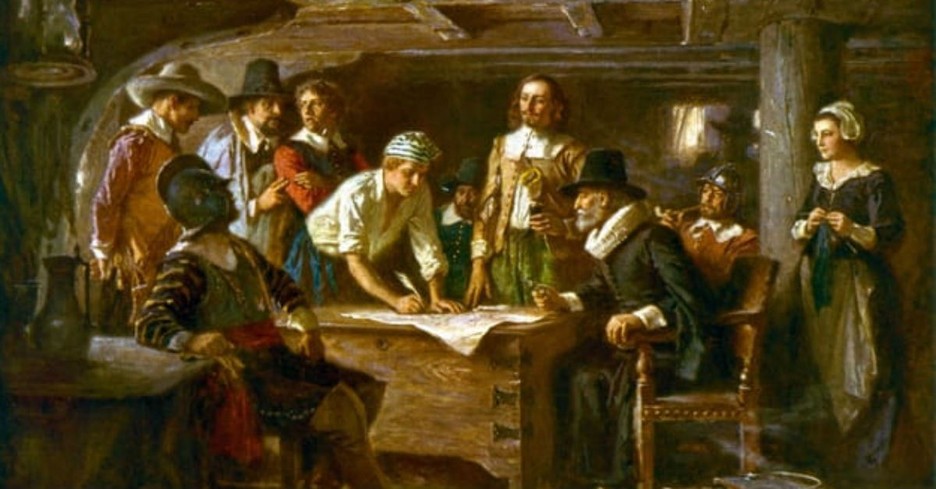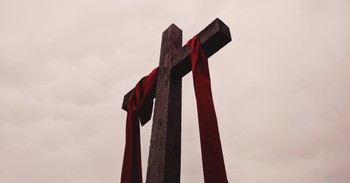
The Magnificient Mayflower Compact
On November 21, 1620, the Pilgrims drew up and signed the Mayflower Compact (which is actually dated the 11th of November because Britain was still using the Julian calendar)... It said: "For the glorie of God and advancement of ye Christian faith, we do... ...covenant and combine ourselves together into a civil body politick...to enact,... and frame... just and equal laws...for the general good of the Colonie, unto which we promise all due submission and obedience."
The compact was modeled after the church covenant that the Pilgrims had drafted and signed in 1607 when they had first separated from the English Church and fled to Holland. For the next fifty years, the Mayflower compact served the Pilgrims well, and it became an important precedent for the idea of a written American Constitution at the Convention of l787.
Pilgrim's Peril
"My knife is sharp enough to carve out a corner of this wilderness for myself," boasted Edward Dotey as he fingered his long, curved cutlass. "And who's goin' to stop me?"
"I'd daresay many of us!" retorted Stephen Hopkins, his fists clenched in anger at this mutinous declaration from one of his own servants.
"Now listen up, Master Hopkins!" Dotey argued. He stood on the deck of the Mayflower, backed by a number of indentured servants and lesser freemen. "When God sent a storm to blow us north, he carried us far away from our destination in the Virginia countryside. We're in a foreign land now. Your Virginia charter has no legal power here. Once we reach land, you've no right to order me to go to bed or rise again. I'll be my own man."
"And I," shouted many of the rebels.
Mutiny on the Mayflower?
The Mayflower was anchored far away from the jurisdiction of its charter for Virginia, but its leaders had no intention to sail farther south. Things may not have happened exactly as we've depicted above, but Pilgrim chronicler William Bradford wrote of the rebellious intent of several who had crossed the cold Atlantic in that fall of 1620. Their survival was at stake. The need of the hour was for a mutual, binding covenant to govern the group in the hard days ahead.
Shortly after these mutinous murmurings, a strategic meeting of the voyage's leaders took place in the captain's quarters. After prayer and much lively talk, Elder William Brewster dipped a quill in ink and began to write. The words he penned are now famous; at the time, they were simply the best-reasoned efforts of a small group of English Separatists to stave off a mutiny while ensuring the common good.
Writing the Mayflower Compact
Elder Brewster wrote: In the name of God, Amen. We whose names are underwritten, having undertaken--for the glory of God, and advancement of the Christian faith--a voyage to plant the first colony in the Northern parts of Virginia, do solemnly and mutually in the presence of God, and one another, covenant and combine ourselves together into a civil body politic, for our better ordering and preservation and furtherance of the ends aforesaid; and by virtue hereof to enact, constitute, and frame such just and equal laws, ordinances, acts, constitutions, and offices, from time to time, as shall be thought most meet and convenient for the general good of the colony, unto which we promise all due submission and obedience.
The ink was barely dry on the Mayflower Compact when the entire ship's company was called together to hear it read aloud. Every man who signed the compact promised to obey the laws that would soon be made for their life together. Every man who didn't sign knew that he'd be considered an outlaw if he disobeyed those same laws. It was Saturday, November 21, 1620.
The next day was Sunday, and all Christians on board--men, women, and children--spent the day praying and listening to the preaching of their minister, Elder Brewster.
On Monday, the men we now call Pilgrims rowed ashore at last to find a place suitable for making a home in the vast American wilderness.

IMAGE ABOVE: The Signing of the Mayflower Compact provided one of the foundational documents for early America. Churchill called it "one of the most remarkable documents in history." The compact was modeled after a church covenant made earlier by a small group of nonconformist believers in Scrooby, England, who later took the pilgrim voyage on the Mayflower to America.
King "Harry Them Out" James
England at the dawn of the 17th century was a land in great social tension. In the religious realm, many Christian Puritans and Separatists were pushing for deeper reform of the Church of England. King James, I grew tired of the reformers' pleas to form their own churches and worship as they wished.
"I will make them conform themselves," he threatened, "or I will harry them out of the land!" James jailed some. Others were watched so closely that they had no freedom to share their faith or gather with like-minded believers.
Unwilling to put up with the persecution, a small group of rural Separatists moved to Holland, where they could worship in freedom. There, they nervously settled in Leyden, a Dutch city which welcomed almost every religious group known to man. Twelve years later, these "pilgrims" packed up and moved again.
The Atlantic Crossing
The Pilgrims decided to take their chances in the New World across the Atlantic. After returning to England to prepare for their journey, they set sail on September 16, 1620. One hundred two men, women, and children crowded onto the tiny Mayflower for the harsh Atlantic voyage. Forty-one of them were Pilgrims, the rest were recruited with no regard to religious convictions. Eighteen were servants and three were hired men. Mostly middle-class, they came from all over England.
Two and a half months at sea. Frigid, violent storms and long, hot days. Cramped quarters with little privacy. The dark, low-ceilinged passenger hold of the Mayflower became a crucible in which God burned away the dross of Pilgrim sins to produce the sturdy character that would soon enrich the American shores.

Not Quite Virginia
At dawn on November 19, 1620, land was sighted. It was Cape Cod, Massachusetts, not Jamestown or the shoreline of Virginia. Here--as everywhere else on the New England coast--there was no established government and no Anglican church. What could be more appealing to this group of Separatists who had crossed the ocean to establish a new and pure Christian society?
But not everyone on board shared the Pilgrims' grand vision. Once landed, the Pilgrims would need a reliable form of government or there could be rebellion. If everyone didn't pull together for the common good, they might all starve in the wilderness. And so they came together in the captain's cabin, where (in the words of Winston Churchill) they "drew up a solemn compact that is one of the most remarkable documents in history."
"For the General Good"
Forged in the fire of necessity, the Mayflower Compact was more a declaration of solidarity among the Pilgrims than it was a document of democracy. But in this brief charter, we have America's first written covenant for a society ruled by common assent and laws of its own making.
Historian George Bancroft wrote: "In the cabin of the Mayflower, humanity recovered its rights, and instituted government on the basis of 'equal laws' enacted by all the people for 'the general good'."
Upon completion of the Compact, one man was elected to act and speak on behalf of the whole company. In choosing John Carver ("a man godly & well approved amongst them") to be their governor, the Pilgrims became the first colonists in the history of the world to name a colonial governor by free election.
An American Covenant
The Mayflower Compact was a natural extension of the Pilgrim church covenant, and it served to hold the Pilgrim colony together in its first, hard days of life upon the wild New England shore.
It was also a reflection of the "treasure" in their hearts. Its words contained their understanding of the right and the ability of the covenanted man (under God) to choose his own leaders, make his own laws, and change those laws for the sake of justice and the overall good of society. Though the Pilgrims had no concept of a fully democratic society (it was only free, adult men who held the right to vote and rule in Pilgrim New England), they were taking bold first steps toward the freedoms that would one day set America apart from all other nations of the world.
Of Plymouth Plantation
Thus out of small beginnings greater things have been produced by His hand that made all things of nothing, and gives being to all things that are; and as one small candle may light a thousand, so the light here kindled hath shone unto many, yea, in some sort to our whole nation.
--William Bradford
Most of what we now know about the Pilgrims came to us through the writings of William Bradford, an early governor of Plymouth. Of Plimoth Plantation, which Bradford completed in 1650, covered the Pilgrim's history from 1606 to 1647. But Bradford never intended it to be published.
He gave the manuscript to his son, who passed it on to his own son, who gave it to Judge Sewall of Boston. The judge gave it to Rev. Thomas Prince, who stuck it in his library high in the steeple of Old South Church. Then it disappeared entirely, stolen when British forces looted Old South in the early days of the American Revolution. Centuries passed, and the importance of Plymouth Colony faded from history's view.
Then in 1855, Bradford's ancient, yellowed chronicle was discovered on a library shelf in Fulham Palace near London, England! It was published for the first time 10 years later in Boston. At last, the fabled Pilgrims came to life in vivid description through this careful and colorful history of Plymouth Plantation.
A 'New" England
"New England" was a phrase invented by Captain John Smith. Pictured Below:

We know Smith best from the old story of how his life was saved by the Powhatan Indian princess Pocohantas during the early days of Jamestown Colony in Virginia. But Smith didn't stay in Jamestown.
In 1614, he explored the eastern coastland of North America from Virginia to Maine. Two years later, back in England, he published a book entitled A Description of New England. The book contained a very accurate map of the region, which the Pilgrims carefully studied for their journey.
Smith heard of the Pilgrims' planned venture and suggested that they hire him as guide and advisor. They thanked him for his offer but told him it would be cheaper for them just to buy his book!
Portions of this article were adapted from the Original Mayflower Compact on Christianity.com
Article Photo Credit: WikimediaCommons


